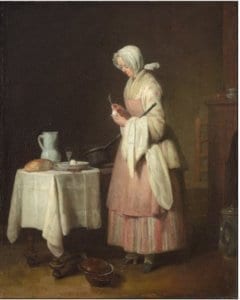The “nurse” peeling a lemon in Chardin’s painting bears scant resemblance to what the modern eye would recognize as a nurse. She holds neither bandages, nor a thermometer, nor medicines. Her “uniform” leans more towards that of a kitchen helper or a housemaid. This is not surprising, because in the days before Florence Nightingale’s reforms nursing had not yet become a profession, and nurses were untrained, often sloppy and incompetent, shown at their worst in Charles Dickens’ novel Martin Chuzzlewit and his character Sarey Gamp, the nurse who had a bottle of gin “on the chimley-piece” to put to her lips whenever “so dispoged”.
But if the Attentive Nurse’s place of work was in the kitchen, so was Chardin’s. Shortly after his marriage in 1731, he made his kitchen his studio, so that the vegetables, fish, bread, meat, and fruit that littered the room became both menu for his meals and subjects for his paintings. Reflecting the artist’s gastronomical interests, the painting shown here was first exhibited 1747 under the title Les Aliments de la Convalesence (Food for the Convalescence), then in Paris as Breakfast prepared (1907), and in Berlin as the Kitchen Maid or Cook peeling a lemon (1910). Whether designed for a convalescent or not, it was clearly food and not nursing that was the center of attention.

The Attentive Nurse. Jean-Baptiste-Simeon Chardin, 1747. National Gallery of Art, Washington, DC.

Leave a Reply